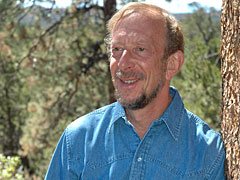Kenny Ausubel (original) (raw)
Kenny Ausubel [back] Hoxsey
Kenny Ausubel is an award-winning social entrepreneur, author, journalist and filmmaker. He is the founder and co-executive directions ofBioneers, a nationally recognized nonprofit dedicated to disseminating practical and visionary solutions for restoring Earth�s imperiled ecosystems and healing our human communities.
When Healing Becomes a Crime --Kenny Ausubel
[1995] The Bioneers: Declarations of Interdependence
DVD
[DVD 1987] Hoxsey; The Quack Who Cured Cancer?
Quotes Under Fishbein's direction, the AMA sailed into a golden harbor of prosperity fueled by surgery, radiation, drugs, and a sprawling high-tech hospital system. The corporatization of medicine throttled diversity. The code word for competition was quackery. When Healing Becomes a Crime --Kenny Ausubel
Organized medicine quickly adopted the stance that his alleged "cures" fell into three categories: those who never had cancer in the first place; those who were cured by prior radiation and surgery; and those who died. When Healing Becomes a Crime --Kenny Ausubel
It was easy for the medical profession to paint Hoxsey as a quack: he fit the image perfectly. Brandishing his famed tonic bottle, the ex-coal miner arrived straight from central casting as the stereotype of the snake-oil salesman. When the AMA coerced the pathologist who performed Hoxsey's biopsies to cease and desist, Hoxsey could no longer verify the validity of his reputed successes. Organized medicine quickly adopted the stance that his alleged "cures" fell into three categories: those who never had cancer in the first place; those who were cured by prior radiation and surgery; and those who died. In exasperation, Hoxsey attempted an end run by approaching the National Cancer Institute. In close collaboration with the AMA, the federal agency refused his application for a test because his medical records did not include all the biopsies. When Healing Becomes a Crime --Kenny Ausubel
Meanwhile Hoxsey struck oil in Texas and used his riches to promote his burgeoning clinic and finance his court battles. Piqued at Hoxsey's rise, Fishbein struck back in the public media, penning an inflammatory article in the Hearst Sunday papers entitled "Blood Money," in a classic example of purple prose and yellow journalism. Outraged, Hoxsey sued Fishbein. In two consecutive trials, Hoxsey beat Fishbein, standing as the first person labeled a "quack" to defeat the AMA in court. During the trials, Hoxsey's lawyers revealed that Fishbein had failed anatomy in medical school, never completed his internship, and never practiced a day of medicine in his entire career. When Healing Becomes a Crime --Kenny Ausubel
These "proven" cancer treatments are themselves largely unproven. The standard of proof for therapeutic efficacy is in fact a double standard. Surgery was grandfathered in as standard practice early in the twentieth century without randomized, double-blind clinical trials, which only became widespread in the 1960s with the advent of chemotherapy. Its dangers and limitations have since been only superficially acknowledged or studied, and little is known about its efficacy in relation to a baseline marker of no treatment.
Like surgery, radiation therapy was grandfathered in without rigorous testing. Radiation is carcinogenic and mutagenic. In the few tests comparing radiation treatment against no treatment, according to Jones, "Most of the time, it makes not the slightest difference if the machine is turned on or not." Jones went even further, saying, "My studies have proved conclusively that untreated cancer victims actually live up to four times longer." Radiation is often combined with surgery despite the fact that tests have generally shown it made no apparent favorable difference. A recent study with patients with the most common form of lung cancer found that postoperative radiation therapy, which is routinely given, actually raises the relative risk of death by 21 percent, with its most detrimental effects on those in the early stages of illness. Nevertheless, radiation is used on about half of cancer patients. When Healing Becomes a Crime --Kenny Ausubel
Clearly, conventional cancer treatments have an important place in medicine and save lives. But since the 1950s, evidence has steadily accumulated that surgery, radiation, and chemotherapy are far less effective than the public is being led to believe. Investigative journalist Daniel Greenberg, writing in the Columbia Journalism Review in 1975, produced the first widely reported expos� showing that cancer survival rates since the 1950s had not progressed, and that improvements from 1930 to 1950 were mainly a consequence of improved hospital nursing care and support systems. Greenberg found that even the valid improvements were very, very small, and that there had been no significant advancements in treating any of the major forms of cancer. When Healing Becomes a Crime --Kenny Ausubel
Pharmaceutical companies pin the high costs of drugs on the forbidding expense of testing and approving each new drug, now pegged at $500 million. In fact, this prohibitive figure has served as a barrier of entry for all but giant corporations. The entire system is founded in patents, twenty-year exclusive licenses that provide monopoly protection. As an herbal product, the Hoxsey tonic cannot be patented and therefore occupies the status of an orphan drug that no company will develop. While approving about forty highly toxic cancer drugs, the FDA has yet to approve a single nontoxic cancer agent or one not patented by a major pharmaceutical company. When Healing Becomes a Crime --Kenny Ausubel